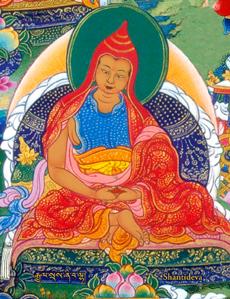Tonglen

Tonglen (Tib. གཏོང་ལེན་, Wyl. gtong len) is the practice of 'giving' or 'sending' (tong) happiness and wellbeing and 'receiving' or 'taking' (len) pain and suffering.[1] It is part of the instructions on 'mind training' (Tib. lojong) brought to Tibet by Lord Atisha, and is specifically related to relative bodhichitta.
Put very simply, the tonglen practice of giving and receiving is to take on the suffering and pain of others, and give them your happiness, well-being, and peace of mind. Tonglen uses the medium of the breath. As Geshe Chekhawa wrote: “Giving and receiving should be practiced alternately. This alternation should be placed on the medium of the breath.”
His Holiness the Dalai Lama says [2]:
- To be able actually to transfer one's happiness to others and directly take their sufferings upon oneself is something only possible on very, very few occasions; it occurs when both oneself and another individual have a very special type of relationship based on karmic affinity, stemming perhaps from a previous life. Why does one cultivate this attitude? Because it leads to attaining great strength of character, courage and enthusiasm; and improves one's own practice of developing bodhichitta.
Sogyal Rinpoche says:
- Of all the practices I know, the practice of tonglen is one of the most useful and powerful. No other practice I know is as effective in destroying the self-grasping, self-cherishing, self-absorption of the ego, which is the root of all our suffering and the root of all hard-heartedness.
Sources
Tonglen is referred to in many Indian and Tibetan sources such as Shantideva's Bodhicharyavatara, the Seven Points of Mind Training composed by Geshe Chekhawa, Langri Thangpa's Eight Verses of Training the Mind, the Thirty-Seven Practices of the Bodhisattvas, the Lam Rim and in Longchenpa’s Mind in Comfort and Ease. There are also special instructions which have been passed down in the oral tradition.
Notes
- ↑ According to Alak Zenkar Rinpoche it is more accurate to call this practice dé duk tonglen, meaning ‘giving happiness and receiving suffering’
- ↑ His Holiness the XIVth Dalai Lama: "Four Essential Buddhist Commentaries", page 97. Library of Tibetan Works & Archives, Dharamsala, India, 2005.
Further Reading
- Pema Chödrön,
- When Things Fall Apart (Boston: Shambhala, 1997), Chapter 15 'Going Against the Grain'
- Tonglen, the Path of Transformation (Vajradhatu Publications, 2001)
- The Places that Scare You (Boston: Shambhala, 2001), Chapter 9 'Tonglen'
- Living Beautifully with Uncertainty and Change (Boston: Shambhala, 2012), Chapter 7 'Breathing In Pain, Breathing Out Relief'
- The Wisdom of No Escape (Boston: Shambhala, 2012), Chapter 12 'Sending and Taking'
- Sogyal Rinpoche, The Tibetan Book of Living and Dying, HarperCollins Publishers, New York, 1992, Chapter 12
- Arousing Bodhichitta, The Heart of the Enlightened Mind—The Bodhichitta Mengak Study Pack (Lodève: The Tertön Sogyal Trust, 2008), pages 132-149.
- Ga Rabjampa, To Dispel the Misery of the World: Whispered Teachings of the Bodhisattvas, translated by Rigpa Translations (Wisdom Publications, 2012)